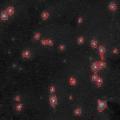You are here
ChlamyCount: Chlamydia inclusion detection system

Institute of Clinical Microbiology, University of Szeged, Szeged, Hungary
Institute of Medical Microbiology and Immunobiology, University of Szeged, Szeged, Hungary
Department of Image Processing and Computer Graphics, Institute of Informatics, University of Szeged, Szeged, Hungary
Department of Dermatology, Paracelsus Medical University, Salzburg, Austria
Cellular Imaging Laboratory, Biological Research Center, Hungarian Academy of Sciences, Budapest, Hungary
Chlamydiae are obligate intracellular bacteria that propagate in the inclusion, a specific niche inside the host cell. We developed an automatic inclusion counting system based on a commercially available DNA chip scanner. Fluorescently labeled inclusions are detected by the scanner, and the image is processed by ChlamyCount, a custom plugin of the ImageJ software environment.
Chlamydiae are obligate intracellular bacteria that propagate in the inclusion, a specific niche inside the host cell. The standard method for counting chlamydiae is the immunofluorescent staining and manual counting of chlamydial inclusions. High or medium throughput estimation of the reduction in chlamydia inclusions should be the basis of testing antichlamydial compounds and other drugs that positively or negatively influence chlamydial growth, yet low-throughput manual counting is the common approach. To overcome the time-consuming and subjective manual counting we developed an automatic inclusion counting system based on a commercially available DNA chip scanner. Fluorescently labeled inclusions are detected by the scanner, and the image is processed by ChlamyCount, a custom plugin of the ImageJ software environment. ChlamyCount was able to measure the inclusion counts over a one log dynamic range with high correlation to the theoretical counts. ChlamyCount was capable of accurately determining the minimum inhibitory concentration of the novel antimicrobial compound PCC00213 and the already known antichlamydial antibiotics moxifloxacin and tetracycline. ChlamyCount was also able to measure the chlamydial growth altering effect of drugs that influence host-bacterium interaction such as interferon-gamma, dextran and cycloheximide. ChlamyCount is an easily adaptable system for testing antichlamydial antimicrobials and other compounds that influence Chlamydia-host interactions.
Download the ChlamyCount ImageJ plugin.
ChlamyCount ImageJ plugin
